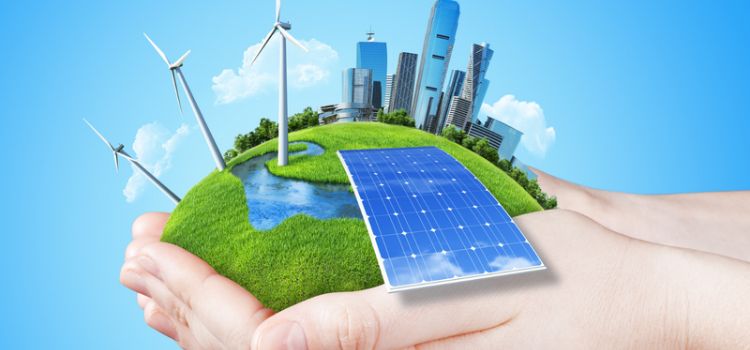
Renewable Energy Market by Type (Wind Power, Hydroelectric Power, Solar Power, Bio Energy, and Geothermal) and End User (Residential, Industrial, and Commercial)- Global Opportunity Analysis and Industry Forecast, 2022–2030
Industry: Energy & Power | Publish Date: 07-Dec-2022 | No of Pages: 366 | No. of Tables: 278 | No. of Figures: 247 | Format: PDF | Report Code : N/A
Market Overview:
The global Renewable Energy Market size was valued at USD 856.08 billion in 2021, and is predicted to reach USD 2,025.94 billion by 2030, with a CAGR of 9.6% from 2022 to 2030.
Renewable energy is derived from natural sources that are replenished at a higher rate than they are consumed. There are various forms of renewable energy, deriving directly or indirectly from the sun or heat generated deep within the earth.
Renewable energy includes energy generated from solar, wind, geothermal, hydropower & ocean resources, solid biomass, and biogas and liquid biofuels. The efficiency of green energy widely depends on its availability and location, while some, such as geothermal are of great use in some locations and not in others, owing to accessibility.
Favorable government policies to curb the carbon footprint
Governments of various developing and developed countries have focused on promoting sustainable energy sources, owing to an increase in output efficiency, low maintenance costs, and less pollution. This is expected to drive the renewable energy industry. The primary objective of deploying clean energy is to advance economic development, improve energy security and access to energy, and mitigate climate change.
Moreover, various governments and organizations are indulged in numerous strategies such as new initiatives, energy usage policies, collaborations, and awareness campaigns. For instance, in November 2021, international governments including the U.S., Canada, Mexico, and the UK jointly committed to fully convert their own fleets of 120,000 vehicles to zero emission by 2040 to reduce greenhouse gas.
Along with this, several utilities, automakers, cities, and EV charging providers across the world are rolling out new pilot programs and services that allow residential and commercial customers to use renewable energy for their EV electricity needs and charge at times that help integrate more sustainable energy sources on the grid.
Government investments in renewable energy sources fuel the market share
Governments across developed and developing economies are undergoing several regulatory changes and are offering subsidies to the corporate sector to adopt renewable energy sources. According to a report by the International Energy Agency, published in June 2022, global energy investments are set to increase by 8% in 2022 to reach USD 2.4 trillion, with the anticipated rise coming mainly in clean energy. Renewables, grids and storage account for more than 80% of the total power sector investments. In addition, spending on solar PV, batteries and electric vehicles is growing at rates consistent with reaching global net zero emissions by 2050.
Moreover, rise in investments as well as industrialization and urbanization lead to growing demand for sustainable energy across the globe. Furthermore, rise in collaboration between countries for development and installation of green power plants leads to growth in the renewable energy market trends. For instance, in August 2022, the Investment Board of Nepal and India’s National Hydro Power Corporation Ltd signed an MoU to develop two projects, West Seti Hydropower Project and Seti River Hydropower Project on the Seti River. The projects are expected to develop a total of 1,200 MW of energy.
High initial capital investments impede renewable energy adoption
The development of new resources involves huge capital investments toward building new infrastructure. High capital requirements ultimately increase the costs of electricity from renewable sources. Therefore, high initial capital investments and a lack of resources in several countries play a major role in hindering the growth of the renewable energy industry. In addition, clean energy systems tend to have little or no fuel, operation and maintenance (O&M) costs, but their initial unit capital costs tend to be much higher than fossil generation systems.
In addition, legal, regulatory, and engineering transaction costs are also generally higher, more complex and do not benefit from economies of scale common to large conventional projects. As a consequence, many commercial banks, utilities and established independent power producers (IPPs) are not interested in pursuing these investments. Hence, the initial high capital cost of renewable energy projects is a barrier to project financing in renewables-based energy.
Technological advancements and energy demand promote significant opportunities.
A significant increase in energy demand, owing to a rise in population, along with surge in investments in renewable energy projects has been witnessed in countries such as China and India. Residential and industrial sectors are expected to consume more energy during the forecast period globally. While Concentrating Solar Power (CSP) receivers like STAR offer some energy storage capabilities, there is a push to develop more robust energy storage systems for renewable technologies.
Some researchers have created a new storage technology system that has been dubbed “sun in a box,” which can store excess energy in white-hot molten silicon. When this excess energy is needed, mounted photovoltaic cells can be actuated into place to convert white-hot light from silicon back into electricity. Moreover, technological advancements in solar PV manufacturing and solving intermittency problems using energy storage systems are expected to provide huge opportunities for the renewable energy market trends in the coming future.
Asia-Pacific currently dominates the renewable energy industry.
Asia-Pacific holds a share of the renewable energy market share, and is expected to continue its dominance during the forecast period. Asia-Pacific accounts for more than half of the global energy consumption with 85% of that regional consumption coming from fossil fuels. Demand for sustainable energy is on the rise, owing to rapid urbanization and industrialization and considerable opportunities exist to avoid long-term lock-in with carbon-based energy technologies.
In addition, primary drivers boosting the renewable energy industry include an increase in investments and initiatives by governments, favorable policies, and advancements in renewable energy technologies. For instance, in June 2021, the government of Japan announced transition from Feed-in-Tariff (FiT) to Feed-in-Premium (FiP), which started in April 2022. The new program allows renewable generators to sell electricity in the spot market at premium to wholesale prices. The change is designed to increase competition in the renewable space while lightening consumer cost burdens.
Moreover, the declining costs of solar modules and the versatility of these systems for various applications, including electricity generation and water heating foster market growth are further accelerating the growth of the market value. For instance, in December 2021, MNRE invited applications for the Expression of Interest in conducting an evaluation study of Phase II of the Grid Connected Rooftop Solar Program. The program is a part of the National Solar Mission, which aims at installing 40 GW capacity of grid-connected solar rooftop installation systems by 2022.
Europe witnesses’ substantial growth in the global renewable energy market.
Europe shows substantial growth in the global renewable energy market owing to significant demand for hydropower and onshore wind energy in the region. In addition, owing to advancements in technology, the cost has been reduced, which makes it an attractive option in terms of investment.
Also, various schemes offered by several governments in this region such as tax benefits to encourage the use of alternative and sustainable power sources are providing further impetus to the green energy industry growth. In July 2022, the government of the UK organized 4th round of contracts for difference, which delivered about 11GW of renewable energy capacity, enough green energy to power around 12 million British homes with clean, affordable, indigenous energy, reducing reliance on uncertain global prices.
Moreover, rising awareness regarding positive effects of green energy also propels the industry growth in this region. In addition, governments of several countries in this region are investing robustly in alternative and sustainable power sources to economize electricity and control environmental hazards, which propels the renewable energy industry growth. For instance, in September 2021, the government of Norway announced USD 9.1 million for developing hybrid hydropower and floating solar energy project led by Scatec. This project will be the first hybrid solar and hydropower plant in the world.
Competitive Landscape
The renewable energy market report includes several market players such as General Electric, ABB Ltd, ACCIONA, Enel Spa, Schneider Electric SE, Xcel Energy Inc., Siemens Gamesa Renewable Energy, S.A., Suzlon Energy Limited, Innergex Renewable Inc, and Tata Power. These market players are adopting expansion of business across various regions to maintain their dominance in the global market.
For instance, in September 2022, GE Renewable Energy received orders from Continuum Green Energy Limited to supply, install, and commission 81 of its 2.7-132 onshore wind turbines for 218.70 MW wind power projects spread across India. These projects aim to power various industries and commercial establishments in Tamil Nadu and Madhya Pradesh, India.
In addition, in February 2022, ABB collaborated with IBM and Worley to sign a memorandum of understanding on helping energy companies build and operate green hydrogen facilities more efficiently and at scale. The planned three-party partnership intends to create an integrated, digitally enabled solution enabling facility owners to construct green hydrogen assets more rapidly, affordably, and safely, and to operate them more efficiently.
Renewable Energy Market Key Segments
By Type
-
Wind Power
-
Hydroelectric Power
-
Solar Power
-
Bio Energy
-
Geothermal
By End User
-
Residential
-
Industrial
-
Power
-
Iron and Steel Industry
-
Chemicals
-
Oil, Gas, and Petrochemicals
-
Food & Beverage
-
Automotive
-
Others
-
-
Commercial
By Region
-
North America
-
U.S
-
Canada
-
Mexico
-
-
Europe
-
UK
-
Germany
-
France
-
Italy
-
Spain
-
The Netherlands
-
Denmark
-
Finland
-
Norway
-
Sweden
-
Russia
-
Rest of Europe
-
-
Asia-Pacific
-
China
-
India
-
Japan
-
South Korea
-
Australia
-
Thailand
-
Singapore
-
Rest of Asia-Pacific
-
-
RoW
-
UAE
-
Saudi Arabia
-
South Africa
-
Brazil
-
Others
-
REPORT SCOPE AND SEGMENTATION:
|
Parameters |
Details |
|
Market Size in 2022 |
USD 971.7 Billion |
|
Revenue Forecast in 2030 |
USD 2,025.94 Billion |
|
Market Volume in 2022 |
8,699.04 |
|
Volume Forecast in 2030 |
23,666.25 |
|
Growth Rate |
CAGR of 9.6% % from 2022 to 2030 |
|
Analysis Period |
2021–2030 |
|
Base Year Considered |
2021 |
|
Forecast Period |
2022–2030 |
|
Market Size Estimation |
Billion (USD) |
|
Growth Factors |
Favorable government policies to curb the carbon footprint. |
|
Countries Covered |
26 |
|
Companies Profiled |
10 |
|
Market Share |
Available for 10 companies |
|
Customization Scope |
Free customization (equivalent up to 80 analysts working hours) after purchase. Addition or alteration to country, regional & segment scope. |
|
Pricing and Purchase Options |
Avail customized purchase options to meet your exact research needs. |
KEY PLAYERS
• General Electric
• ABB Ltd.
• ACCIONA
• Enel Spa
• Schneider Electric SE
• Xcel Energy Inc.
• Siemens Gamesa Renewable Energy, S.A.
• Suzlon Energy Limited
• Innergex Renewable Inc.
• Tata Power




 Speak to Our Analyst
Speak to Our Analyst

































